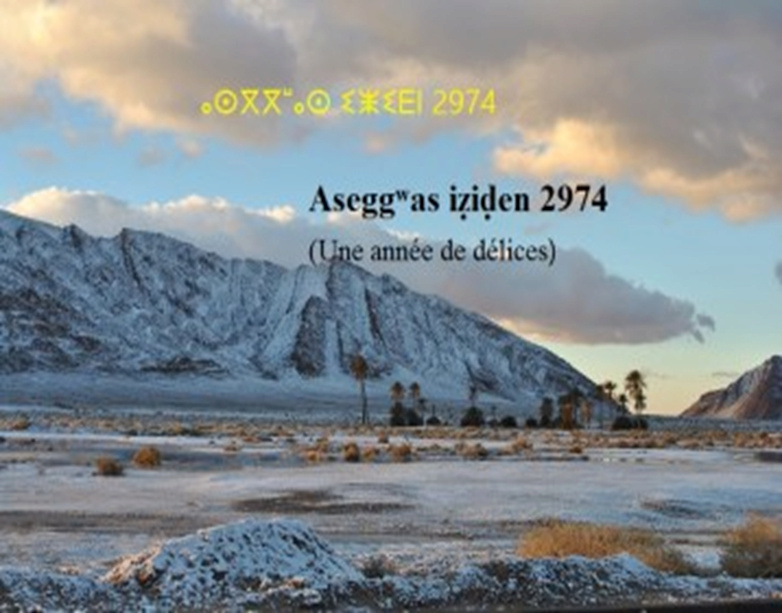The celebration of Nnayer in Figuig

There is a note on the way in which Nnayer is celebrated in the ksour of Figuig in the south-east of Morocco like all Imazighen in the world.
This party and celebration obeys the principle of generosity and sharing. The vital substance, food, must circulate generously and any greed is judged negatively and considered harmful to the regeneration of nature and the life of the community.
Nnayer is the occasion of absolute generosity for all foods and for all things. The following auspicious prayer explains this fact:
!An ntech al d nilez
!Niṛḍ al d nilez
!Nsew al d nilez
!Neṭṭeṣ al d nilez
!Naden al d nilez
Let's eat until there's nothing left
! Let's dress until there's nothing left
!Let's drink until there's nothing left
!Let's sleep until there's some left
!Let's cover up until there's nothing left

During Nnayer we leave food in the pots and fill all the available utensils with this vital material. This principle of generosity even establishes itself as a custom relating to all meals: by drinking whey together, we try not to be the one who finishes this liquid. Of the one who drinks the last sip, it is said that he choked his mother iḥney yemmas. But alcohol drinkers say that someone who drinks the last sip from a bottle is going to get (re)married. This is how we ritually experience cosmic rhythms.
Nnayer or yanayur (New Year's Day)
The celebration of the New Year is considered in the scientific world as a cosmogonic ritual, of renovation of the World and rebirth of Life. By celebrating the New Year, one wishes to undo the past year and expel or avoid the evil forces, illnesses and famines that have manifested there.
Nnayer corresponds to the first month of the agrarian/Amazigh year and it is the middle of the local winter. This day corresponds to Gregorian January 14. Its eve (the 13th) is called igzinen (cub of an animal such as a puppy, a lion cub, etc.); during this night, we make a wheat couscous with multiple vegetables utšu n yirden for dinner during which each member of the family receives or takes a ball of butter, hence the name igzinen. After this dish, we leave a ball of couscous in a ladle inside a pot: it is the dinner of the spirits or ghosts izɣuɣen or izquqen. All creatures will have something to eat. Part of the meal must remain so that – as an omen – food will be abundant throughout the year. This celebration is based on abundance and renewal: we leave a ball of date on aylim (skin which serves as a workbench for preparing flour), couscous in a ladle, sauce in the pot and we fill all the utensils in our possession of food so that the year may be abundant. There must be some leftover food. “Nnayer must not arrive and find people hungry because they risk staying there,” says local wisdom. » We clean the house, we clean the hearths or fire pits and remove all the ashes that were there and we make ourselves beautiful. We bury the past year to celebrate the next in cleanliness, satiety, cheerfulness and abundance. The remains and ruins of the previous year are buried or destroyed so that something truly new can begin. On the day of New Year, we organize a berkoukes (gros grain couscous) with all the vegetables available, all the meats and tripe available and varied for lunch (red meats, white meats, meats preserved or not, tripe dried or not etc.) . In this meal, a date stone is buried; the one who finds it while eating the meal is considered the luckiest of his family but also as the one who must take care of it for a year. Some families use three to seven date stones or even a whole date.

Speaking of the passage of time, the most significant time of the year is certainly the celebration of the New Year. Mircea Eliade notes that "there exists everywhere a conception of the end and the beginning of a temporal period based on the observation of bio-cosmic rhythms (1)" As a period of transition, the transition to the new year resumes a cosmogonic model, that of the passage from Chaos to Cosmos: Creation. Everything that took place before this new Creation is destroyed like the sins which are canceled thanks to the expulsion of a scapegoat.
Source : Benamara Hassane, A Berber mythology, L'Harmattan, 2021, pp. 170-172.

